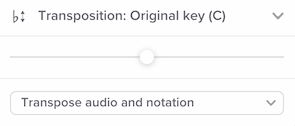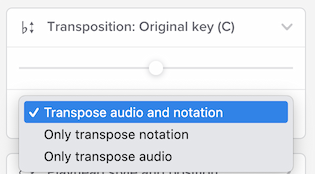Transposing sheet music and audio
Whether you’re learning music that was written for a different instrument, or you’re challenging your knowledge of a piece with a new key signature, you can easily transpose music in Soundslice.
Just open the settings panel via the button at lower right of the player, then drag the “Transposition” slider:

Transposing audio
This feature can also pitch-shift the audio to reflect the new transposition, but it depends on the type of recording you’ve currently selected. See here:
| Type of audio | Audio transposition supported? |
|---|---|
| Synthetic | Yes. |
| MP3 playback | Yes, if enhanced slowdown is enabled. Otherwise, no. |
| YouTube playback | No, because YouTube doesn’t allow this. |
| Video playback | No. |
If audio transposition is indeed available for your current recording, you’ll see an extra option appear below the transposition slider. By default it will say “Transpose audio and notation”:

Click that for fine-grained control over what specifically is transposed:

The options are:
- Transpose audio and notation
- Only transpose notation
- Only transpose audio
Forcing concert pitch
If the music you’re viewing has at least one instrument that’s a non-C transposing instrument — for example, a clarinet in B flat — then the settings Transposition section will also include a “Concert pitch” checkbox:

If you check this box, the music will automatically be rewritten in concert pitch. Note that this doesn’t affect the sound, only the notation. This option takes effect even if you’ve selected “Only transpose audio.”
For more on transposing instruments, see Working with transposing instruments.
Will chord diagrams change to reflect the new transposition?
You bet!
Will tablature change to reflect the new transposition?
Yes! Caveats apply, though. We try to keep things relatively playable, but it might result in difficult (or unplayable) fingering.
A note regarding downward transposition: it’s possible to transpose downward such that some notes are impossible to play (i.e., they’re lower than the lowest-pitched string). In this case, we’ll hide those notes’ tablature but continue to display the notes in the staff. We’ll also give you a heads up message, “Some music might be unplayable”:

If I change the transposition of a slice, will it remember my setting the next time I load it?
No. A slice will always start in its original transposition.
But if you’re editing a slice you’ve created yourself, you can indeed transpose permanently. See our separate help page on this.
How far can I transpose?
You can transpose one octave in either direction (up or down).
I’m creating music in Soundslice. How can I set instrument transposition for non-C instruments, such as clarinet?
See our separate page here for information on working with transposing instruments.
How can I restore the music to its default transposition?
Move the transposition slider back to the center. You’ll see the text “Original key” when you’ve done this.
As a slice creator, can I set the default transposition for audio?
Yes, see pitch correction for audio.
I’m editing some music in Soundslice. How can I transpose a selection of it?
See our separate help page about permanent transposition, which is an editor function.